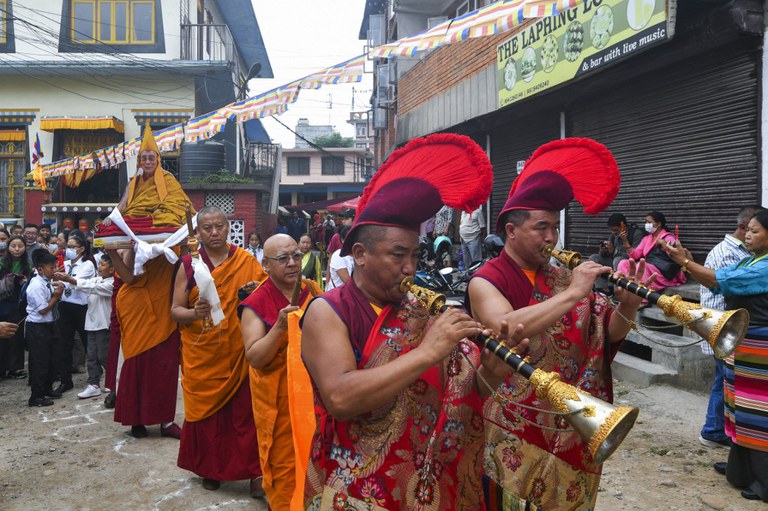North Korean soldiers who died of COVID-19 symptoms after participating in a military parade in April are receiving an honorable war death certificate that used to confer bereaved families with special privileges, but is essentially worthless these days, sources in the country told RFA. After two years of denying the coronavirus had penetrated its closed borders, North Korea in May acknowledged coronavirus had begun to spread among participants of the large-scale military parade held at the end of the previous month and declared a “maximum emergency” to fight the disease. The soldiers who developed symptoms of COVID-19 after the parade and died while in quarantine were quickly cremated and their remains were returned to their families along with the once prestigious “Certificate of Honor for War Death.” In years’ past, the certificate was given out only in the rarest of circumstances, such as when a soldier died in combat training or during the infrequent skirmishes with the South Korean military that occasionally erupt along the demilitarized zone that separates North from South. Bereaved families who received the certificate would also get extra food rations or special preference when applying for government jobs or party positions. But the sheer number of certificates sent out these days, combined with North Korea’s struggling economy, make the certificates essentially worthless, sources told RFA. “Immediately after the massive military parade held in Kim Il Sung Square in April, the soldiers who were confirmed to have COVID-19 received intensive treatment at an isolation facility in Pyongyang,” a resident of the North Korean capital told RFA’s Korean Service on condition of anonymity for security reasons. “But hundreds of the severely ill patients died and they were promptly cremated at the Obongsan crematory,” he said. The cremations were ordered even before families were aware that their soldier had died, the source said. When they informed the families, they said the soldiers died while receiving treatment for an “acute respiratory infection,” stopping short of calling the infection COVID-19. “Because the military parade was considered a success thanks to the sacrifice of the dead soldiers, the authorities awarded the families with the Certificate of Honor for War Death when they returned the ashes of their loved ones,” he said. “The bereaved families wept at the sudden news, and they returned home with a cremation urn and the certificate as gifts from the state. A month and a half later, many of the families are still angry at the authorities, who they say have put these young soldiers in unnecessary danger, even killing some of them, for the sake of a military parade,” said the source. The parade involved more than 100,000 military officers, soldiers and college students from all over the country, with students from the military university in Pyongyang participating in large numbers, another source from the city, who requested anonymity to speak freely, told RFA. “I heard from an official of the Capital Quarantine Committee that many of the students were among the participants in the parade who died from COVID-19,” the second source said. “The authorities secretly transported the dead bodies to the Obongsan crematory in Pyongyang. They cremated the bodies and gave the bereaved family an urn and the Certificate of Honor for War Death,” she said. The certificate this time carries less meaning than it did in the past, according to the second source. “It is customary to hold a public award ceremony as a national event for recipients of the Certificate of Honor for War Death, but the authorities quietly called on the bereaved families, because they want to keep secret the total number of parade participants who died from COVID-19,” she said. “The bereaved families… were unable to say anything and wept while receiving the certificate. They are resentful at the thought that their healthy sons died because of a military parade,” she said. While technically not fighting and dying in a battle, the parade participants are eligible for the certificate because they carried their military ID cards during the parade. On this technicality the parade was designated as combat training. The certificate is merely a means to placate the bereaved families though, according to the second source. Under normal circumstances the state would give many perks to the families who received the certificate including priority in personnel decisions, because the soldier died in battle or in combat training. But these days, due to North Korea’s extreme economic hardship, and because most personnel decisions are decided through bribery, the certificate is no longer valued as it once was. In fact, the state has been widening the circumstances where soldiers can receive the certificate to justify giving more of them out, according to the second source. “If soldiers die while working at a construction site, that should be treated as a labor safety accident, but there have been many cases where the Certificate of Honor for War Death is given when soldiers die while working on the Pyongyang Household Construction project, because it is a priority of the Highest Dignity,” said the second source, using an honorific term for the country’s leader Kim Jong Un. Kim has vowed to build 10,000 new homes in the capital per year for a total of 50,000 homes by the end of 2025. The builders failed to reach their goal of 10,000 homes in 2021 but are still trying to hit 20,000 by the end of this year, so speed, rather than safety is the main concern, the second source said. Giving out the war death certificate for deaths that are clearly unrelated to combat is becoming more common, a former high-ranking military official, who has resettled in South Korea after escaping the North, told RFA on condition of anonymity for safety reasons. “It’s just a trick to avoid complaints from the bereaved families and residents. They are angry at the leaders who held the parade [amid the pandemic], causing so many young people to die,” he said. The North Korean government has only reported a handful…





